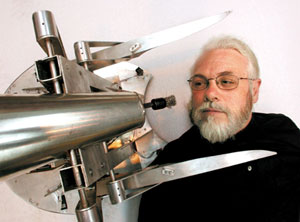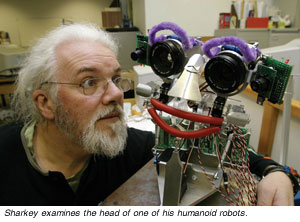|
by Lay Leng TAN

 o Noel Sharkey, robots are merely metal or silicon devices empowered by a human brain - not sci-fi androids running amok and taking over the world as popular movies and books such as I, Robot or Artificial Intelligence have suggested. In Singapore recently to judge a National Junior Robotics Competition for students, the computer science professor at the University of Sheffield, England, maintains: "Artificial intelligence (AI) is not the same as animal or human intelligence; robots are programmed devices. They are just computer systems really. The only way they can become dangerous is when used in military applications; the more automated they become, the more dangerous they can be." o Noel Sharkey, robots are merely metal or silicon devices empowered by a human brain - not sci-fi androids running amok and taking over the world as popular movies and books such as I, Robot or Artificial Intelligence have suggested. In Singapore recently to judge a National Junior Robotics Competition for students, the computer science professor at the University of Sheffield, England, maintains: "Artificial intelligence (AI) is not the same as animal or human intelligence; robots are programmed devices. They are just computer systems really. The only way they can become dangerous is when used in military applications; the more automated they become, the more dangerous they can be."
Can a human then teach a robot to "think"? He is doubtful even as he designs biologically inspired robots. "I look at bacterial intelligence. Single-cell organisms are smart, and by smart, I don't mean they can play chess. They have been around millions of years - they can breed and survive and will still be here when we are gone; so as a species, bacteria are very clever. By understanding how they form structures and defend themselves, we can build robots that are simple chemical computers like bacteria."
 Mimicking living organisms proves a big challenge as nature has had a long time to perfect its designs. Sharkey asserts: "You get very complex behaviour from very simple designs like unicellular living things, and when you figure out how some organisms work, they are amazingly simple." Mimicking living organisms proves a big challenge as nature has had a long time to perfect its designs. Sharkey asserts: "You get very complex behaviour from very simple designs like unicellular living things, and when you figure out how some organisms work, they are amazingly simple."
He has developed a well-known robot system called "Predator and Prey," the concept behind which is to make the system self-sustaining without human intervention. Prey robots receive their energy from sunlight; predator robots, using a genetic learning algorithm, hunt them to steal battery power to survive. The research looks for stable points in evolution where the predators get enough energy but not so much as to kill off the prey. This type of work has practical implication in extreme environments such as interplanetary exploration and travel.
The Mars Rover robot that landed on Mars in 2004 was satellite controlled and moved very slowly. To study a planet closely, scientists need to release many efficient robots to perform various tasks using solar energy. Sharkey believes specialist predator robots will work better in this context as they can track down energy-loaded prey robots and recharge themselves.
Since the 1950s, people have predicted that in about 25 years robots will move into the home and take over domestic chores. In a way, they were not wrong as such domestic "robots" as vacuum cleaners have appeared; they were wrong only about the time line, according to Sharkey.
One reason for the time lag was the technical difficulty involved in getting a robot up and down stairs. In the end, engineers made a portable vacuum cleaner. Rather than wait for the perfect robotic system, companies decided to build a home appliance to gain a foothold in the household. This change of mindset lets people get accustomed to a robot in their homes. The appliance "robot" thus paves the way for the introduction, and more ready acceptance, of complex machines as they are developed.
Inventors also seek to popularise robots by way of toys. Sharkey sees this sector as having potential for the greatest growth. Sony's AIBO toy dog, a huge success, is sought-after worldwide. Again, the idea was to get into households, this time with a toy, and then go for greater functionality. In fact, Sony offers academics and researchers the use of AIBO as a low-cost programmable robot platform to encourage more work on robotics. Sharkey views the move as a big step forward: "They are not really just toys but are simple devices. They will tell us what consumers want so we can begin to develop platforms on top."
The most significant breakthrough in robotics has been the humanoid walking robot. The main problem lies in the speed of computational processing. When this robot started to tip over, the computer did not provide feedback fast enough for it to right itself. By the time the information came, it had fallen. Once Honda managed to surmount this stumbling block and made a workable model, many global research centres and institutes also started working in this area, including the National University of Singapore, Nanyang Technological University, and Singapore Polytechnic.
To date, however, innovation has been mechanical rather than intelligent, Sharkey analyses. Vision limits the advancement of household domestic systems - a robot cannot differentiate among separate items put close together, a result of "network stupidification."
Researchers look to neural science to learn how human vision fundamentally works. Instead of focusing on program modules that make vision work, they have now turned to parallel processing and neural processing to integrate vision's functions. Colour detection represents an effective method for robots to find objects. For example, in the pharmaceutical industry, robots can quickly locate and mix drugs of certain colours or with tinted labels.
Sharkey sees sensing technology as moving rapidly - laser sensing, sonar sensing, and insect-vision replication. Singapore has been world champion in soccer robotics several times. Commercial enterprises may call this seemingly trivial activity a waste of time, but in making such robots, engineers actually tackle many difficult challenges - coordinating robot tasking, motion planning, fast-motion control, and the like. The knowledge has implications that can lead to the development of automated devices for cleaning up environmental waste or working in hazardous conditions.
Sharkey sees that Singapore has a niche in humanoid robotics. For instance, kicking a ball involves balance. The next stage is to make robots that interact with people. Androids will be able to bridge this gap as they resemble humans sufficiently that people can relate to them more easily and cooperate more quickly. This is quite a challenge as robotics is a field spanning multiple disciplines. "To build a sensible robot, you need knowledge of life and behaviour, psychology, electrical engineering, mechanical engineering, physics, computer science, and sensing. You need to know enough to get a team to integrate it all."
Sharkey walks the talk because he embraces many disciplines. He lectures in engineering, philosophy, psychology, cognitive science, linguistics, artificial intelligence, and computer science. Besides holding a doctorate in experimental psychology, he is a chartered electrical engineer and a chartered information engineer; a fellow of the Royal Institution of Navigation, the Institution of Electrical Engineers, and the British Computer Society, and a member of both the Experimental Psychology Society and Equity (the actor's union).
The multitalented engineer thinks robots are useful in education because of these myriad elements. If teachers can interest children in robotics, they can learn something about all these subjects and how they combine. Japanese researchers have moved far ahead in mechanisms of robotics because they get industry funding. Thinking for the long term, companies are willing to invest in the young to build up the sector.
Sharkey's convictions about education spur him to hold robotics competitions and give lectures to inspire youth, using such platforms as television, museums, and classrooms. A senior fellow of the Engineering and Science Research Council in the United Kingdom, he feels his mission lies in working with the community and the media to generate interest in the technologies of engineering. He has been chief judge for every series of Robot Wars around the world and has held museum exhibitions that bring integrated engineering, science, and technology directly to the public. "Engineering has the reputation of being very dull. If young people felt that that there was more to it than traditional and that they can could change things, their interest would rise."
Looking ahead, Sharkey sees the usefulness of the well-developed machine-learning algorithm for robotics and many other tasks. Neural networks can help programmers do things like diagnose the diesel engine because learning programs can get down to the process level and build up knowledge from humans. The programs can be used for monitoring ship hulls to detect cracks and promise exciting possibilities in other applications.
However, the expert does not foresee the day when robots become intelligent. "I believe that biological material is special. You can simulate a magnet in a computer and see it attract other simulated objects. You can model a thunderstorm in a computer, but you will never get wet. Similarly, you can simulate intelligence, but it will never be real intelligence because biological material is special matter that has internal interactions we do not understand yet. It is aware of the world, and computers have no awareness."
Maybe one day in the future, scientists might employ cloning and stem-cell manipulation to create intelligence - a scenario that does belong in sci-fi .
 Click here to download the full issue for USD 6.50 Click here to download the full issue for USD 6.50
|



 o Noel Sharkey, robots are merely metal or silicon devices empowered by a human brain - not sci-fi androids running amok and taking over the world as popular movies and books such as I, Robot or Artificial Intelligence have suggested. In Singapore recently to judge a National Junior Robotics Competition for students, the computer science professor at the University of Sheffield, England, maintains: "Artificial intelligence (AI) is not the same as animal or human intelligence; robots are programmed devices. They are just computer systems really. The only way they can become dangerous is when used in military applications; the more automated they become, the more dangerous they can be."
o Noel Sharkey, robots are merely metal or silicon devices empowered by a human brain - not sci-fi androids running amok and taking over the world as popular movies and books such as I, Robot or Artificial Intelligence have suggested. In Singapore recently to judge a National Junior Robotics Competition for students, the computer science professor at the University of Sheffield, England, maintains: "Artificial intelligence (AI) is not the same as animal or human intelligence; robots are programmed devices. They are just computer systems really. The only way they can become dangerous is when used in military applications; the more automated they become, the more dangerous they can be."
 Mimicking living organisms proves a big challenge as nature has had a long time to perfect its designs. Sharkey asserts: "You get very complex behaviour from very simple designs like unicellular living things, and when you figure out how some organisms work, they are amazingly simple."
Mimicking living organisms proves a big challenge as nature has had a long time to perfect its designs. Sharkey asserts: "You get very complex behaviour from very simple designs like unicellular living things, and when you figure out how some organisms work, they are amazingly simple."
 Click here to download the full issue for USD 6.50
Click here to download the full issue for USD 6.50